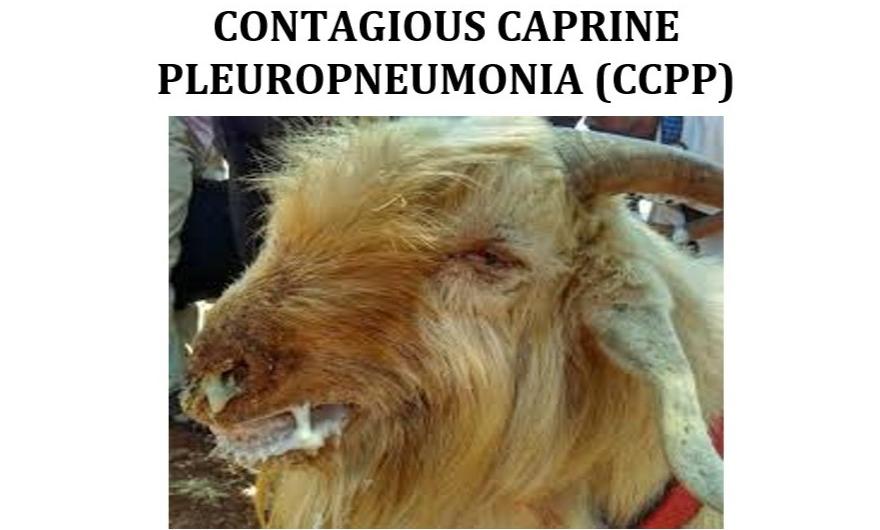Contagious Caprine Pleuro Pneumonia (CCPP)
- It is contagious disease of goat having resemblance with CBPP.
- Disease is responsible for severe pneumonia outbreaks in goat herds.

Etiology:
- Mycoplasma mycoides subspecies caprae
- mycoides sub sp. mycoides has been considered as principal cause of pleuropneumonia in kids upto 6 months.
Epidemiology:
- Disease is distributed globally in tropical countries.
- In India, disease has been reported from Assam, Chennai, Mumbai, Haryana, Uttar Pradesh, Bihar, West Bengal.
- In naive herds, morbidity is often 100%, and mortality may reach 80%.
- In a study conducted to determine seroprevalence of CCPP in Bharatpur Municipality, Chitwan from July to October 2021, seroprevalence was reported to be 4.71%.
- Seroprevalence was high among females and goats below or equal to 5 years, however it was not significant statistically.
- In similar study conducted in Rupandehi and Palpa district from Jan. 2020 to March 2020, seroprevalence was reported to be 3.37%.
Transmission:
- Infection is spread mainly through inhalation.
- Organism donot live long outside the animal’s body.
- Bot fly has been found to spread the infection.
- Factors like high-density farming, poor ventilation, stress, and the introduction of infected animals into healthy herds can facilitate the spread of CCPP.
Pathogenesis:

Clinical Findings:
- Incubation period is about 4 days.
- Fever (104-106°F), weakness, dullness, anorexia, tachypnea, dry painful cough and nasal discharge are typical findings.
- Respiratory distress with open mouth breathing and frothy salivation.
- Sudden death may occur without any signs in acute and severe form.
- Nasal discharge is watery initially which progresses to thick mucopurulent to white later.
PM Findings:
- There is typically appreciable straw-colored pleural effusion and acute fibrinous pneumonia.
- Consolidation is sometimes confined to one lung.
- In antimicrobial-treated or recovered animals, a sequestrum similar to that observed in CBPP may develop.
- The lung is granular with copious straw-colored exudates.
- Pea-sized, yellow nodules may be found in the lungs; these nodules are surrounded by areas of congestion.
- The regional (bronchial) lymph nodes are enlarged.
Diagnosis:
- Based on history and clinical findings
- Based on PM findings
- Isolation of organism from tissue through culture. Special PPLO media are used for growth of organism.
- Blood picture shows decreased RBC and hemoglobin and increased serum glucose and urea nitrogen.
- CFT, ELISA
- PCR is used for molecular characterization.
Differential Diagnosis:
- PPR:
- Along with respiratory signs, diarrhea (foul-smelling) is usually evident.
- Nasal discharge usually stains the nasal area.
- Hemorrhagic septicemia (HS):
- Disease is often induced following stress usually after transportation.
- Cranioventral bronchopneumonia is observed.
- Disease responds to common antibiotics.
- Contagious agalactia (MAKEP) syndrome:
- Along with respiratory signs, mastitis, arthritis, metritis, enteritis, keratitis and septicemia are observed.
Treatment:
- CCPP can be treated with oxytetracycline, Rolitetracycline, Chloramphenicol and Tylosin.
- Tylosin @40mg/kg, b.wt. for 5 days
- Tiamulin @36 mg/kg, b.wt. gave satisfactory response.
- Tylosin tartrate @10mg/kg, b.wt. IM along with cotrimoxazole tablet for 5-7 days have been suggested.
- Long acting oxytetracycline @20mg/kg, IM, once is effective in treatment of CCPP.
Control Measures:
- Isolation of sick animals from rest of herd.
- Dead goats should be disposed off properly. Carcass are either burnt or buried deeply.
- Strict sanitation measures should be implemented in goat shed premises.
- Biosecurity measures such as foot bath with lime water, disinfection of shed with sodium hypochlorite, potassium permanganate should be done.
- Newly purchased animals should be quarantined before mixing into herd.
- Vaccination of animals in susceptible herd. Vaccine consist of live culture of caprae. Dose: 0.2 ml to be given at tip of ear. Revaccination at 6-month interval is recommended.